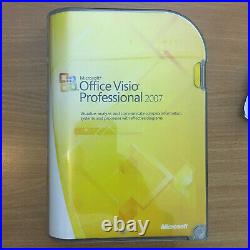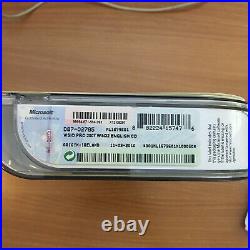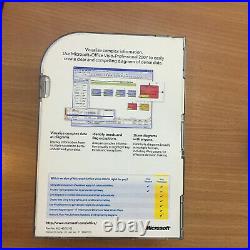Microsoft Office Project Professional 2007 Retail Edition




Microsoft Windows Vista Home Premium Upgrade. Microsoft Office Project Professional 2007 (Full Retail Edition NOT OEM). Microsoft Office Project Professional 2007(Retail Edition NOT OEM). Microsoft Project is a project management software. It is designed to assist a project manager.
To tasks, tracking progress, managing the budget. Microsoft Project was the company's third Microsoft Windows-based application.
Within a few years after its launch, it became the dominant PC-based project management software. It is part of the Microsoft Office. Family but has never been included in any of the Office suites. It is available currently in two editions, Standard and Professional. Microsoft Project's proprietary file format.Microsoft Project and Microsoft Project Server. Are the cornerstones of the Microsoft Office.
Project' was an MS-DOS software application originally written in Microsoft'C' (and some assembly) language for the IBM PC. The idea originated from the vision of Ron Bredehoeft, a former IBM S/E and PC-enthusiast in the early 1980s, to express the recipe and all preparation for a breakfast of eggs Benedict.
Bredehoeft formed Microsoft Application Services (MAS) during the birth of the application and the company later entered an OEM agreement with Microsoft Corporation. Boyd, Microsoft's Manager of Product Development, introduced the application as an internal tool to help manage the huge number of software projects that were in development at any time inside the company. Boyd wrote the specification and engaged a local Seattle company to develop the prototype. The first commercial version of Project was released for DOS. Microsoft bought all rights to the software in 1985 and released version 2.
Version 3 for DOS was released in 1986. Version 4 for DOS was the final DOS version, released in 1986. Version was released in 1990, and was labelled version 1 for Windows. Development continued until Microsoft Project 4.0 for Mac in 1993.
Microsoft Project 4 for the Mac included both 68k and PowerMac versions, Visual Basic for Applications and integration with Microsoft office 4.2 for the Mac. In 1994, Microsoft stopped development of most of its Mac applications and did not offer a new version of Office until 1998, after the creation of the new Microsoft Macintosh Business Unit the year prior. The Mac Business Unit never released an updated version of Project, and the last version does not run natively on Mac OS X. Microsoft Project 1.0 was the only version to support Windows 2.
It came bundled with Windows 2. Runtime but was fully compatible with Windows 3.0, especially Standard and Enhanced modes.
The setup program runs in DOS, like the most Windows-based applications at the time. Microsoft Project 3.0 introduced macro support, toolbars and Planning Wizards and was the last to support Windows 3.0.The setup program now runs in Windows, and it is based on Microsoft's own setup program, which was also used by e. Microsoft Visual Basic 2.0/3.0, Works 2.0, Access 1. It was the last 16-bit version. Additionally it was the first version to use VBA.
File format support and ability to create reports. This version allowed user to consolidate up to 80 projects. Microsoft Project 95 (4.1) was the first 32-bit version and it was designed for Windows 95.It introduced ODBC support, AutoCorrect, Answer Wizard, like all Office 95. Updated version, called Microsoft Project 4.1a improved Windows NT support. Additionally it was the first version to be available on CD-ROM.
Additionally it was the last version to open Project 3.0 files. Microsoft Project 98 was the first to use Tahoma. Font in the menu bars, to contain Office Assistant. Like all Office 97 applications, introduced view bar, AutoFilter, task splitting, Assignment Information dialog, resource availability dates, project status date, user-entered actual costs, new task types, multiple critical paths, in-sheet controls, ability to rename custom fields, Web publishing features, new database format, Task Usage, Tracking Gantt and Resource Usage views, Web. Features, Web toolbar, PERT analysis features, resource contouring, cost rate tables, effort-driven scheduling, cross-project linking, indicators, progress lines, ability to save project files in HTML. Format, ability to analyze time-scaled data in Excel, improved limits for the number of tasks, resources, outline levels etc. And Microsoft Office Binder support, Microsoft Outlook. Timeline integration, selective data import and export, ability to save as Microsoft Excel. Microsoft Project Map, and allowed user to consolidate 1,000 projects. It was the last version to run on Windows NT 3.51. The last to open Project 4.0/95 files and save in. Project 98 SR-1 was a major service release addressing several issues in Project 98. Microsoft Project 2000 was the first to use personalized menus, Microsoft Agent. Based Office Assistant and to use Windows Installer. Based setup interface, like all Office 2000. Applications, and introduced Microsoft Project Central (later renamed Microsoft Project Server). PERT Chart was renamed Network Diagram and was greatly improved in this version. Notable new features include ability to create personal Gantt charts, ability to apply filters in Network Diagram view, AutoSave, task calendars, ability to create projects based on templates and to specify default save path and format, graphical indicators, material resources, deadline dates, OLE DB, grouping, outline codes, estimated durations, month duration, value lists and formulas custom fields, contoured resource availability, ability to clear baseline, variable row height, in-cell editing, fill handle, ability to set fiscal year in timescale, single document interface. Add-ins, pluggable language user interface, roaming user and Terminal Services. Support, ability to set task and project priority up to 1,000 (previously 10) and HTML help. Project 2000 was also the last version to support Find Fast and to run on Windows 95. Project 2000 SR-1 fixed several bugs.Microsoft Project 2002 was the first to contain task panes, safe mode, smart tags, "Type a question for help" in the top right corner, mandatory product activation. And ability to open and save Microsoft Project Data Interchange.
It was also the last version to run on Windows NT 4.0. It was available in two editions for the first time, Standard and Professional.Office Assistant is installed but not enabled by default. Support for accounts with limited rights under Windows 2000/XP was improved. Microsoft Project 2003 was the first to support Windows XP. And to contain Windows XP-style icons, like all Office 2003.
Applications, and the last to contain Office Assistant. (not installed by default) and to run on Windows 2000.Microsoft Project 2007 was the last to contain the menu bar and toolbars. Office Assistant was removed entirely. Microsoft Project 2010 was the first to contain ribbon and Backstage view, like all Office 2010. Applications, and the last to open Microsoft Project 98 and. Mpx files and to run on Windows XP and Vista.
Additionally it was the first 64-bit version. Microsoft Project 2013 was the first to contain Modern UI. Based look, and introduced Microsoft account and OneDrive.
Microsoft Project 2016 is the last to support Windows 7. Microsoft Project 2019 runs only on Windows 10. And it contains features carried over from Office 365. Versions for Windows were released in 1990 (v1.0), 1992 (v3.0), 1993 (v4.0), 1995 (Project 95, v4.1a), Project 98 (v8.0), Project 98 SR-1 (1999), Project 2000 (v9.0), Project 2000 SR-1 (2001), Project 2002 (v10.0), Project 2003 (v11.0), Project 2007 (v12.0), Project 2010 (v14.0), Project 2013 (v15.0) and Project 2016 (v16.0). There was no Version 2 on the Windows platform; the original design spec was augmented with the addition of macro capabilities and the extra work required to support a macro language pushed the development schedule out to early 1992 (Version 3). Microsoft Project 2007 showing a simple Gantt chart. Project creates budgets based on assignment work and resource rates. As resources are assigned to tasks and assignment work estimated, the program calculates the cost, equal to the work times the rate, which rolls up to the task level and then to any summary tasks and finally to the project level. Resource definitions (people, equipment and materials) can be shared between projects using a shared resource pool. Each resource can have its own calendar, which defines what days and shifts a resource is available. Resource rates are used to calculate resource assignment costs which are rolled up and summarized at the resource level. Each resource can be assigned to multiple tasks in multiple plans and each task can be assigned multiple resources, and the application schedules task work based on the resource availability as defined in the resource calendars.All resources can be defined in label without limit. Therefore, it cannot determine how many finished products can be produced with a given amount of raw materials. This makes Microsoft Project unsuitable for solving problems of available materials constrained production. Additional software is necessary to manage a complex facility that produces physical goods.
The application creates critical path. Third-party add-ons also are available.
Schedules can be resource leveled. And chains are visualized in a Gantt chart. Additionally, Microsoft Project can recognize different classes of users. These different classes of users can have differing access levels to projects, views, and other data. Custom objects such as calendars, views, tables, filters, and fields are stored in an enterprise global which is shared by all users.
Project is available in two editions, Standard and Professional; both editions are available either as 32 or 64bit options. The Professional edition includes all the features of the Standard version, plus more features like team collaboration tools and ability to connect to Microsoft Project Server. Table of Microsoft Office 2007 Editions.Office Customization Tool is used to customize the installation of Office 2007 by creating a Windows Installer patch. MSP and replacing the Custom Installation Wizard and Custom Deployment Wizard included in earlier versions of the Office Resource Kit that created a Windows Installer Transform.
Please confirm what you required and we would forward price details and related information. (Just off the A41, 2 miles from M1/A5/A41 BrentCross interchange). We only supply equipment sourced from UK distribution which is thus official UK specification product.
This includes problems with: compatibility, driver/software conflicts, improper installation, etc. All sales are considered final. We have been caught out only the once and now take precautions that would most certainly involve legal action being taken should you be found guilty of fraud. Don't waste your time or our's. This item is in the category "Computers/Tablets & Networking\Software\Operating Systems".
The seller is "snet-technologies" and is located in this country: GB. This item can be shipped worldwide.
- Type: Full
- Number of Licences: 1 Licence
- Licence Details: Retail Single
- Media Type: DVD
- Category Subtype: Office 2007
- Country/Region of Manufacture: Ireland
- Operating System: Windows Vista, Windows XP, Windows 7, Windows 10,
- Format: CD
- Manufacturer Warranty: None
- Brand: Microsoft
- Platform: Windows
- EAN: 882224157476
